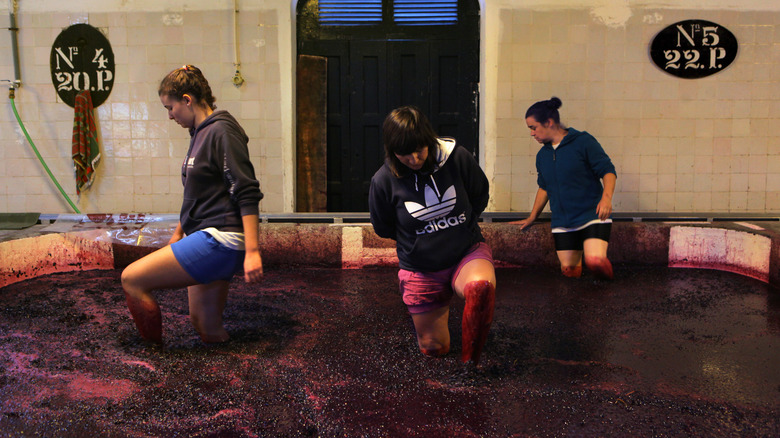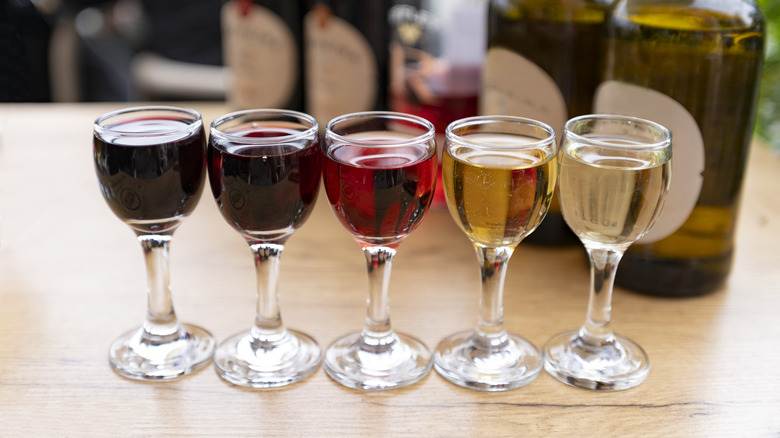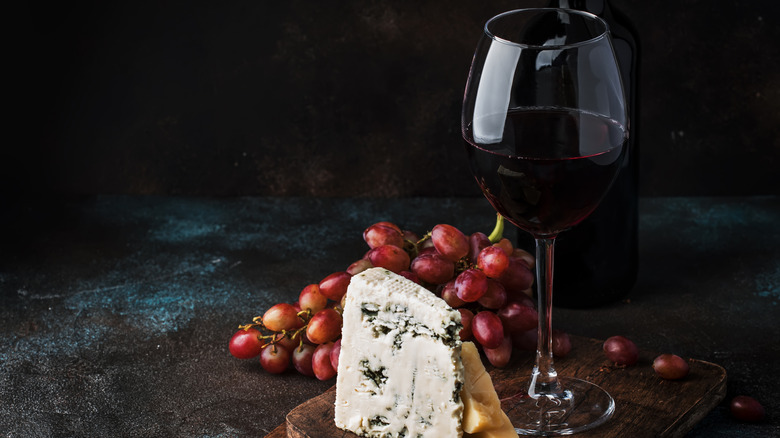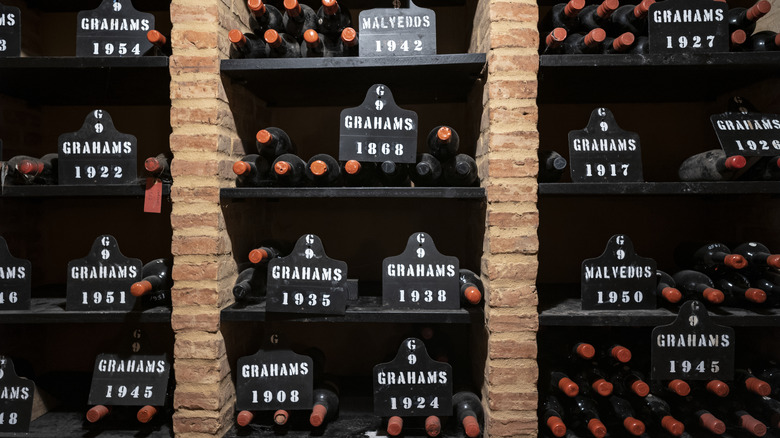
Alexander Spatari/Getty Images
We may receive a commission on purchases made from links.
If you’ve heard of port before, but never tasted it, the name may remind you of something a grandparent used to drink after dinner, a beverage to sip on by a fireplace, or something found exclusively as a villainous treat in mystery novels. Port does have a somewhat mystifying reputation as a drink exclusively reserved for retirees, or for those who only have a sweet tooth. I’ll admit that while as a lover of wine and a former bartender, I was familiar with port, but I hadn’t spent much time drinking or learning about it.
However, in 2023, I traveled to Portugal, and had the opportunity to visit and stay in Porto for a few days, where port wine originated and is proudly sold and displayed in every shop you might come across. I took the time to do port winery tastings, go on tours, and educate myself about this spirit, which as it turns out, is much more complex than I — or maybe you — might have realized. Port wine has a rich history and there are many varieties and flavor profiles beyond the very sweet stuff that has earned an unfair reputation. Read on for more information about this misunderstood drink!
The history of port wine

KazT/Shutterstock
Let’s start with a bit of history. Technically, just as real Champagne can only be produced in the Champagne region of France, real port wine comes from the Douro Valley, located in the northern part of Portugal. This area has a particularly friendly climate for the types of grapes used in port production, which we’ll cover momentarily. The Alto Douro region is practically pre-historic, known as the world’s oldest demarcated wine region, and now certified as a UNESCO World Heritage site.
Brandy was added by British merchants to Portuguese wine to help preserve it while traveling, and inadvertently helped create the sweet staple for centuries to come. References to the fortified wine known as “port” date back to the late 1600s, and part of the reason it’s so associated with the city of Porto is not due to the production, but rather the exports that came through the city. Wine would travel down the Douro River and be unloaded in the town center of Oporto (or Porto, as it’s more commonly known), where it could be aged, bottled, and shipped.
How is port wine made?

David Silverman/Getty Images
Part of what makes port wine sweeter (and more alcoholic), is the fortification process, where an additional spirit is added to the original grape liquid. In this case it’s brandy, or specifically, aguardente. The brandy kills the yeast, halting fermentation, which preserves the existing sugar in the wine. That natural sweetness gives port the dessert taste most drinkers know, with approximately 100 grams of sugar per liter and a heightened alcohol content. The mixture is then typically aged in oak starting at up to a year and a half.
There are around 30 types of grapes commonly used for port, with about half a dozen being the most popular. Some of those are Touriga Franca, Touriga Nacional, Tinta Roriz, Tinta Barroca, and Tinta Cão. More traditional wine producers may still use the foot stomping method to produce their grape juice in stone troughs known as lagars, although the modern approach has been mechanized.
What does port wine taste like?

Pollyana Ventura/Getty Images
It would be an oversimplification to say all port is just “sweet” — each variety has its own flavor profile, and there are notable colors and styles. There are four main categories of port: ruby, tawny, and rosé, which all come from red wine grapes, and white, which is made from white wine grapes.
Within those demarcations, you can break down port even further. For example, within the ruby family, which are red in color, you also see vintage, late-bottled vintage (LBV), and crusted (defined by the aging process). Rubies are the youngest (making it the most affordable) and fruitiest ports, with flavors including dark cherry, blackberry, cinnamon, and chocolate. It is also meant to be served with the least amount of chill, just below room temperature.
In the tawny family, you’re likely to get notes of caramel, hazelnut, clove, and fig. They are aged longer (up to 40 years) in oak barrels, allowing for oxidation, which also makes them smoother, and they appear tawny brown or amber. The temperature to drink tawny port at is cooler than ruby, from 50 to 58 degrees Fahrenheit. The rosés are pink in color and have strawberry, raspberry, and cranberry notes, and are unaged. These are the newest port variations, having been introduced in 2008. Serve very cold — 39 degrees Fahrenheit is recommended. Finally, white ports have apricot, apple, and citrus notes, with a nutty finish. These should also be served cold (42 to 50 degrees Fahrenheit), and can even be mixed in with cocktails like a gin and tonic.
What to pair with port wine

5ph/Getty Images
As you might suspect, as each style of port wine has its own flavor profile, there are different recommended food pairings for each. However, in general, rich flavors and foods are advised, including, of course, dessert.
Ruby ports can be paired with most cheeses, particularly a Brie or Stilton, as well as chocolate, and specifically dark chocolate. With a tawny port, try salted nuts, or a cheese with a more nutty flavor to enhance those notes in the spirit. And because of that nuttiness, you could also try an almond-based dessert, or something silky and/or caramel flavored, like a pecan pie or crème brûlée. Rosé ports are good for spicy foods, and white ports, much like a standard white wine, tend to pair well with salads, sushi, and seafood.
You can also use port wine in your own cooking, although be sure to get one of the affordable, non-vintage bottles, if you’re using it in a chocolate dessert or as a reduction, like a balsamic glaze. It can be a substitute for a sweetener, like brown sugar or maple syrup.
Where to buy port wine

Tim Graham/Getty Images
Of course, if you find yourself in Porto as I did, you should take advantage of the many port wine wineries and buy a bottle in its homeland! However, port has become ubiquitous enough these days to find in most liquor, wine, and even grocery stores. (Keep an eye out for the mark of “Porto” on the label to ensure it is certified port.)
If you’re looking for a “good” bottle, of course everyone’s palate varies, but there are some highly reviewed options. Croft Reserve Tawny has a 4.4 out of 5 rating on Amazon, with one user exclaiming, “Absolutely delicious!” If you’re like to try a ruby port, for a more affordable choice Graham’s Six Grapes Reserve Ruby Port rings up under $30 on Wine.com. Wilfred Wong of Wine.com says this has “always been one of my favorites.” For a white port, consider Fonseca Siroco White Port, available on Amazon with a 4.5 star rating. Chasity Cooper, a wine culture expert told Food & Wine, “It is sophisticated, crisp, and refreshing.”
How much alcohol is in port wine?

Peter Meade/Getty Images
As a reminder, while port may be a member of the wine family, you should keep in mind that the alcohol content is much higher due to the added brandy during fermentation. A typical port will have 18%-22% ABV, and should be enjoyed in smaller pours. The standard serving size for port is 75 milliliters, so instead of a typical wine bottle of 750 milliliters that serves 4-5 glasses, remember that a port bottle should have about 10 glasses inside — and take small sips!
That’s also why a standard port wine glass is reduced in size, sometimes referred to as a “tulip” glass, with a narrow rim and bulbous shape. The compact glass will help to remind the drinker of the serving size, but a proper glass will also help reveal the aromas.
Another reason rich foods might be a good pairing with the port wine, beyond balancing the flavors and scents, is to help absorb some of that added alcohol content.
How to enjoy and store port wine

stockcreations/Shutterstock
Similar to most wine, a cool and dark area like a cellar is best for port, stored on its side. (Although do sit it right side up at least a day before serving.) As mentioned previously, particularly rosé and white ports should also be chilled before serving.
Not every port needs to be decanted, although the older bottles (vintage and crusted) should be to prevent sediment build up. If stored properly, a vintage bottle can be kept for 100 years. Interestingly, ports do tend to last longer once opened — a ruby can stay fresh in the refrigerator for a couple of weeks, while a tawny can keep up to a couple of months!
Although port is commonly served after meals as a digestif, if you’re looking for other ways to enjoy port beyond just a simple sip, there are cocktail recipes that incorporate the spirit, as well. You could simply swap white port for gin in a Port and Tonic, or try a tawny port in an Old Fashioned instead of whiskey.

